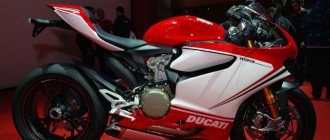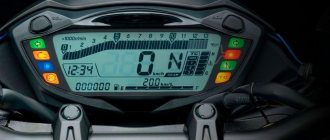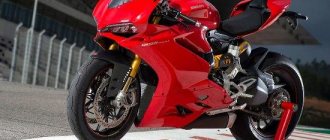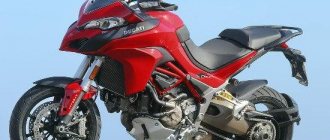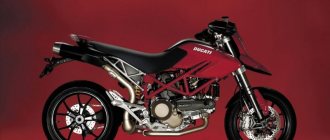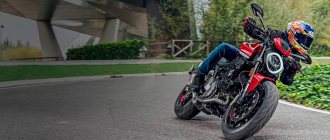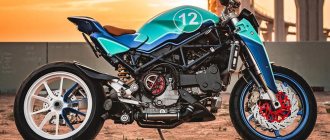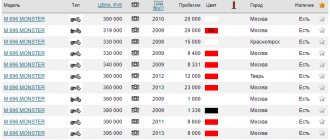RU-MOTO RATING
- Reliability
- Chassis
- Appearance
- Comfort
4
Verdict
The Ducati Monster 696 is a typical naked motorcycle, specially designed for riding on the streets of a metropolis in congested conditions. Here the device is unrivaled: light, maneuverable and well controlled by the steering wheel.
The naked essence of this bike - the frame and mechanisms uncovered by plastic panels - fascinates with power and strength. Studying the review of Ducati Monster 696 , you understand that the manufacturer managed to create a truly iconic device. The motorcycle was produced from 2008 to 2014 and is the direct successor to the “monster” that was developed and rolled off the assembly line in 1993. Designed and manufactured by the famous Italian company Ducati Motor Holding SpA
Video
The Ducati Monster 696
is the latest word in the urban development of the “Street” class. You can happily ride it calmly along your favorite city routes, and in moments of courage you can reveal its entire “dark” side.
Monster's original heritage is a balance of high technology finished in a stylish package. A comfortable and reliable chassis in combination with a quiet but powerful Ducati L-twin engine guarantees a pleasant motorcycle trip.
The Ducati Monster 696 exudes individuality that makes the bike stand out from the crowd. The removable seat cover allows the single seat aerodynamic racing seat to shine. The sleek fairing adds similar polish to the front of the bike.
Competitors
“Monster” has several analogues in its class: BMW F800FR, Suzuki SV650 and Kawasaki ER-6f. In comparison with them, we can highlight the following advantages of the Monster 696 Ducati motorcycle:
- high maneuverability;
- bright appearance.
However, in the following parameters, “Monster” is somewhat inferior to its competitors:
- maximum speed;
- saddle height;
- driver comfort on the road.
This motorcycle is purely urban. It's good for relatively short trips, and you can rely on it in traffic jams.
Possible motorcycle malfunctions
The motorcycle is characterized by specialists and owners as quite reliable and not causing much trouble. The most common malfunctions:
- Melting of the plastic screen and fuel line pipes located next to the exhaust. The repair consists of installing additional thermal insulation.
- The engine crankcase may be damaged at the side stand attachment point. If detected, replacement is required.
- Destruction of steering limiters. They are restored by removing old parts and installing new ones.
You can purchase original Ducati Monster 696 spare parts and have them repaired at the company’s specialized services.
Motorcycle tuning
The market offers a wide arsenal of components to customize the device and improve its characteristics. The most common type of tuning: installing direct flow pipes in place of standard mufflers. For trips in cold weather, larger glass and heated grips are installed. When choosing sliders for installation on a model, it is recommended to give preference to designs with aluminum adapters.
Ducati Monster 696 custom
Read other motorcycle reviews Voskhod 3M: nostalgia for the past
Tuning ducati Monster 696
Engine
In L-twins, qualified specialists and developers of the Ducati motorbike decided to consistently apply all available and acceptable drive schemes for the upper camshaft, as shown in numerous Ducati Panigale 1199 photos: to begin with, they used schemes with shafts, as well as bevel gears, then switched to schemes with belt, but now the developers have decided to use a standardized circuit with a chain drive.
This has its undoubted advantage, at least for mechanics. For example, there will be much more work for them using the new scheme (according to the statement, service intervals will be equal to 24 thousand kilometers).
There is another revolutionary change that directly affected the design of the engine - this is the transition in the use of working bearings. Previously, these were roller main bearings, but now the developers have switched to plain bearings. It was this solution that made it possible to significantly increase the size and characteristics of the crankshaft journals so as not to inflate the crankcase.
Ducati Panigale
Therefore, the developers of the Ducati 1199 motorcycle did not lie when they stated that the desmodromic drive remained from the old engines, as well as the L-shaped arrangement of cylinders with a 90-degree camber angle.
Although the L-shaped placement in this case can be considered only conditional. The thing is that the developers sought to move the entire power unit as far forward as possible. Due to this, they loaded the front wheel. As a result, the front cylinder rose significantly.
Therefore, it is not so far from the classic and familiar V-shaped placement. Another achievement: weight distribution is 52/48 percent, if we are talking about a person of average fatness.
Video
Ducati Monster 796
– an intermediate link in the “monster” family, it is located between the 696 model for beginners, and the 1200th version for experienced bikers. Such an impressive exterior of a motorcycle could only be created in Italy; the designers combined retro features with strict lines and sharp edges of the high-tech style.
The technical base of the Ducati Monster 796 matches its appearance. The engineers took the 87 hp, 803 cc Hypermotard engine and put it in a tubular Trellis space frame. Four-piston Brembo brakes quickly put a damper on this monster's hot temper, despite its 167kg weight.
The layout of the Ducati Monster 796 allows the driver to sit quite low, the seat height is 800 mm, and when stopping you can stand on the ground with both feet. Thanks to the shape of the tank, the motorcycle is easy to grasp with your knees, and the wide handlebar is comfortable to hold with your hands and control the “monster” on city streets. The tricky instrument panel shows a lot of parameters, but Ducati tries to make the information on the display as accessible and easy to read as possible.
Owner reviews
Review of ducati monster
One of the reviews of the ducati monster
Reviews from motorcycle owners are generally favorable and, above all, note the advanced engine design. “Monster” is designed for use in cities, is distinguished by excellent maneuverability and the ability to literally filter through traffic jams. Fans are distinguished by a rather low fit, however, even for those with a height of more than 180 cm, it is quite comfortable.
Motorcycle Monster 400
The beginning of a whole category of neoclassical motorcycles was laid by the Ducati Monster 400 model. The design of the motorcycle was completely absent of any fairings or decorative elements, leaving only a bare engine and frame in appearance. The appearance of this bike in the early 1990s created a new class of naked motorcycles.
The model weighing 184 kilograms was equipped with a 78 horsepower engine, which allowed the motorcycle to accelerate to 210 km/h with an acceleration dynamics of 3.5 seconds.
The Ducati Monster 400 lived up to its name, combining excellent handling, audacity and power. The motorcycle's temper, however, turned out to be too frightening for most motorcyclists, which is why the company introduced the 600th model to the market in 1995. No changes were made to its design, but in terms of handling and technical characteristics it was softer and friendlier.
Versions with 400 cc engines with a capacity of 53 horsepower were produced especially for the Japanese market - novice motorcycle enthusiasts in Japan are allowed to drive motorcycles with exactly this cubic capacity.
Owners of Ducati Monster motorcycles said in their reviews that the release of this model marked the beginning of the concern's return to its roots: engineers launched a road motorcycle model similar to earlier models - Elite, Marianna and Scrambler.
The excellent combination of innovative and refined solutions from Ducati engineers was also noted - the proprietary frame previously used in the 851 and 888 models, and the Supersport engine with an air-oil cooling system.
Crash tests
The consequences of falls in the case of the Ducati Monster are often predictable - the steering wheel rarely breaks and the geometry of the chassis changes, but very often all attachments crumble (this applies to a greater extent to second-generation motorcycles), engine covers are rubbed, mufflers are bent and scratched. If sliders are installed, it breaks out the front ear on the frame where the engine is mounted and breaks the rear part of the crankcase where it is attached to the frame. Therefore, there is only one recipe - try not to fall. If a motorcycle with a dry clutch falls on the right side, the clutch cover usually goes to another world and the inner drum breaks off behind the disc mount. The front brake and clutch levers along with the rear brake pedal are consumables! The left side drop is more expensive due to the left cover being made of magnesium alloy (not weldable). Particularly strong impacts may damage the generator rotor.
Features of the chassis and their design
Another feature of the motorcycle is the radically new approach that was used when creating the body. The developers abandoned the “birdcage” frame, but this spatial frame was traditional for the company.
For the updated design, monocoque technology was proposed. The engine and the suspension units attached to it became the supporting element used for all used components. Also, a lightweight external frame made of aluminum was attached to the engine as a supporting element. This frame ties together two parts of the motorcycle, that is, the front part and also the rear part.
Both the rear and front suspensions are adjustable. Up front is a 50mm fork with 120mm of travel. The fork angle is 24 degrees and 50 minutes. As for the rear suspension, it is equipped with a pendulum. This pendulum is attached directly to the engine. Suspension travel is as much as 130 millimeters.
There are 10 spokes on the wheels. The front wheel measures 3.5 by 17 inches, and the rear wheel measures 6 by 17 inches. The front wheel has 120/70 high-speed tires, and the rear wheel has 200/55. Both tires are the same model – Pirelli Diablo Supercorsa SP.
Ducati Panigale R
Why is motorcycle popular?
The Ducati 1199 Panigale S can rightfully be considered one of the best, and even revolutionary models of sports superbikes. It was created specifically for races and prize-winning places in championships such as World Superbike, and almost immediately adapted for frantic, but relatively calm riding on public roads.
What is especially pleasing is that the motorcycle was ultimately able to exceed even the most daring and daring expectations in terms of power, performance, design and handling. The only thing that slightly spoiled the performance was the cost of the motorcycle. Due to the inflated cost, the motorcycle was not entirely accessible to the general public.
Of course, the creators took this nuance into account, and that is why they created the Ducati 899 Panigale. It was the same motorcycle, but it was only made as a budget version. As for the Ducati Panigale 1199, it remains a source of pride for extreme sports enthusiasts, as well as an object of worship for consumers.
Ducati Panigale 1199
Features of Monster 796 for 2013!
Celebrating the 20th anniversary of the Monster line, this bike features matching bright, even festive colors for the frame, brake calipers, and other parts. Ducati is undoubtedly a very fashionable brand that represents true Italian style for the truest connoisseurs. All three models: Monster 696, 796 and 1100 EVO are available in red. And also 696 is offered in a dark “carbon” color; 796 in arctic white, black silk; 1100 EVO in red with white and grey.
Background [edit]
Since its launch in 1993, Ducati has sold over 200,000 Monsters, at one time accounting for 60% of Ducati's production. The original Monster was cheap and easy to build, and remained so throughout its long life. [1] Ducati's "less is more" rationale for the Monster line aimed to pack high performance into a compact motorcycle. Ducati recently updated the Monster line, adding redesigned components to improve performance and appearance. [2]
Features of the 20th Anniversary Edition:
- Exclusive color;
- Fuel sensor on the tank;
- Bronze frame color;
- The brake calipers are painted gold;
- Chrome headlights;
- Mirrors in the style of the 90s;
- Retro font in model and manufacturer inscriptions;
- Shields on the exhaust system to protect the passenger;
- Aluminum air intakes.
The motorcycle has been produced since 2011.
| engine's type | L-Twin cylinder, 4 valve Desmodromic air cooled |
| Volume | 803 cc cm |
| Bore and stroke | 88 x 66 mm |
| Compression ratio | 11:01 |
| Maximum power | 87 l. With. at 8250 rpm |
| Maximum torque | 58 Nm at 6250 rpm |
| Lubrication system | Pressure lubrication, wet sump |
| Carburetor | Fuel injection (Siemens electronic fuel injection, 45mm throttle body) |
| Clutch type | Wet, multi-disc, hydraulically controlled |
| Ignition system | Digital |
| Starting system | Electric |
| Transmission system | Constant mesh, 6-speed |
| type of drive | Chain |
| Frame | Tubular steel lattice frame |
| Front suspension | Marzocchi 43mm fully adjustable fork |
| Front suspension travel: | 120 mm |
| Rear suspension | Progressive linkage with preload and rebound adjustable Sachs monoshock |
| Rear suspension travel | 148 mm |
| Fork angle | 24 ° |
| Front brake | 2 x 320 mm discs, 4-piston radial calipers |
| Rear brake | 245 mm disc, 2-piston caliper |
| Front tire size | 120/70 ZR17 Pirelli Diablo Rosso, Y-shaped, 5-spoke light alloy 3.50 x17 |
| Rear tire size | 180/55 ZR17 Pirelli Diablo Rosso, Y-shaped, 5-spoke light alloy 5.50 x 17 |
| Length | n.d. |
| Width | n.d. |
| Height | n.d. |
| Seat height | 800 mm |
| Wheelbase | 1450 mm |
| Minimum ground clearance | n.d. |
| Fuel tank capacity | 15 l |
| Oil system capacity | n.d. |
| Mass with technical liquids | 167 kg (dry) |
Video
Ducati Monster 796 review
Ducati Monster 796
– an intermediate link in the “monster” family, it is located between the 696 model for beginners, and the 1200th version for experienced bikers. Such an impressive exterior of a motorcycle could only be created in Italy; the designers combined retro features with strict lines and sharp edges of the high-tech style.
The technical base of the Ducati Monster 796 matches its appearance. The engineers took the 87 hp, 803 cc Hypermotard engine and put it in a tubular Trellis space frame. Four-piston Brembo brakes quickly put a damper on this monster's hot temper, despite its 167kg weight.
The layout of the Ducati Monster 796 allows the driver to sit quite low, the seat height is 800 mm, and when stopping you can stand on the ground with both feet. Thanks to the shape of the tank, the motorcycle is easy to grasp with your knees, and the wide handlebar is comfortable to hold with your hands and control the “monster” on city streets. The tricky instrument panel shows a lot of parameters, but Ducati tries to make the information on the display as accessible and easy to read as possible.
Ducati motorcycles
Ducati is a famous Italian manufacturer of sportbikes and all-terrain motorcycles with an L-shaped engine. The company was founded in 1926 in Bologna. At first, Ducati produced radio equipment, but the factories were destroyed during the Second World War and after it the company began producing engines for motorcycles.
By the end of the 50s, the company successfully competed in motorcycle racing with the powerful Ducati 250 Twin motorcycle. A feature of most Ducati V-twin engines is that the angle between the cylinders is 90 degrees, and one of them is parallel to the ground. This served as the basis for the name of the line of engines - L-shaped.
In addition to the unusual engine, Ducati motorcycles had another feature - the “desmodromic” valve system. This design was developed by engineer Fabio Taglioni, and, largely thanks to it, the company successfully competed in sports competitions. A special feature of this system is the use of a cam drive for the valves. The industry of that time could not provide the required quality of springs for closing valves at high speeds, and the new “desmodromic” system allowed Ducati motorcycles not only to increase efficiency and engine life at high speeds, but also to increase torque at the bottom.
In the 60s and 70s, Ducati continued to compete successfully in racing, improving its sports motorcycles. It was in the 70s that L-Twin engines gained sports fame and became widespread among “civilian” motorcycles.
In 1983, Ducati was acquired by the Castiglioni family and the company merged with the Cagiva group. At this time, Ducati sportbikes continue to be improved and the first model from the Ducati Monstr line of universal motorcycles, which is still popular today, is released.
In the mid-90s, Ducati changed ownership again - the company was acquired by the Texas Pacific investment group. Ducati sports bikes actively and successfully compete in the prestigious World Superbike series.
Success in the World Superbike series pushed Ducati to participate in the MotoGP World Championship. For this purpose, a Ducati Desmosedici GP motorcycle with a V-shaped four-cylinder engine was specially released. In 2007, Ducati wins the MotoGP World Championship.
Now Ducati continues to adhere to the principle of “win a race today, sell a bike tomorrow”, spending about 10% of its budget on sports. Thanks to this spending, the company has a very strong position in sportbikes, superbikes and road bikes. The company is also actively developing enduro motorcycles and cruisers, trying to gain a foothold in new market segments.
Technical features
It makes sense to consider issues of maintenance and design bottlenecks in the general case, since over the years of evolution the family was built around similar components and assemblies, and numerous modifications and upgrades only slightly adjusted the already established design.
There are rumors about all Italian motorcycles and the Ducati Monster in particular that they are inhumanly complex, capricious and expensive to maintain. Experienced “monster breeders” and specialized servicemen have an absolutely opposite opinion. “Monster” is not much different in complexity from other “Japanese” or “Germans”. He's just different! Local specifics must be known and taken into account. And if you can still do some minor work yourself, then it’s better not to get into the engine and chassis unless absolutely necessary.
The Monster engine (regardless of the configuration) is amazingly reliable! It takes a lot of effort to finish him off. The key to successful operation is: the constant presence of the required amount of oil inside and control over the valve mechanism drive belts. Such an unpleasant surprise as increased oil waste is not typical for this power unit. Strong zhor occurs only on significantly “rolled” samples; 100–200 grams per 1000 km of track is within the norm for a large V-shape. Air-oil cooling, and especially liquid cooling, behave correctly in the vast majority of cases. Overheating may result from improper maintenance. A properly tuned Ducati will never overheat! The gearbox also works flawlessly; problems with gears slipping and false neutrals are very rare.
The factory-recommended schedule for replacing belts and checking the desmodromic drive for the first generation is 5000–7000 km, but in practice the belts can easily be maintained up to 12,000 km. With the advent of the second generation, a single interval was introduced for all models - 10,000–12,000 km. Timing belts are changed by an experienced mechanic within 15–20 minutes, the cost of work is on average 3,500 rubles. Access to the valve mechanism is quite free, but work on its adjustment can take two to three hours for motorcycles before 2008. and at least twice as much for fresh specimens. The average cost of service work is 7,000 rubles. The first sign of valves “hanging” in the open position is that the engine loses compression and, as a result, stops pulling normally. Every 10,000–15,000 km, it makes sense to climb into the valve mechanism with a feeler gauge and just run through the gaps; it is not at all necessary that you will have to adjust.
Curiously, the desmodromic mechanism itself is by no means an invention of Ducati. The patent belongs to the English engineer Arnott. Desmodrive started its journey with Peugeot and Mercedes-Benz racing cars.
The Monster's fuel system, as with any other motorcycle, requires synchronization from time to time. It is important to know that versions with an injector are under no circumstances synchronized across instruments due to the unequal length of the drain manifolds and the difference in thermal load across the cylinders. Motorcycle mechanics who are not familiar with this “trick” do not always cope, resulting in unstable engine operation. Specialists in the field, no matter how wonderful it may look, perform the work by ear. The carburetors are absolutely identical to those installed on the Yamaha TRX 850 and Yamaha TDM 850; they can be easily adjusted using standard means. The housings on the “four hundred” and on engines with a volume of 600 cm3, 750 cm3 and 900 cm3 are identical, the filling is different. The 900 additionally has oil heating for the float chamber.
The dry clutch, which has become a Ducati signature over the years (wet clutches are only found on the Monster 400 and Monster 600 Dark), comes straight from motorsport. There is no particular need for such a design at the moment. In the circle of motorcycle racers in the mid-80s, there was a simple but surprisingly true saying: “kill the clutch, kill the engine.” The motivation is approximately the same as in the case of the use of “desmodrome” in racing cars - poor quality of oil, aggravated by the insufficient strength of the friction linings. Athletes of those years were forced to balance on the brink. Very often, under excessive loads on engines with clutches in an oil bath, the friction linings crumbled and rushed straight into the engine crankcase, from where they spread further. Natural consequences could have occurred before the rider and the motorcycle ended up in the pits. A dry clutch does not have this problem.
When in full working order, a dry clutch is slightly noisier than its liquid counterparts. But the signature almost legendary “bucket with nuts” rumble is formed only due to significant wear on the teeth with which the discs hold the basket. And the louder the noise, the more wear. The positive aspects of a dry clutch include a significantly simplified procedure for removing and installing discs. The average mileage between replacements is from 10,000 km to 15,000 km (it all depends on the driving style). Untimely replacement of disks, as a rule, also sends the basket to another world, which is why the cost of repairs increases many times over. If there is severe overheating (for example, in a traffic jam), the intermediate metal discs may become deformed.
One of the key mistakes that gives rise to the rumor that Ducatis are very jerky at the start is insufficient attention to the maintenance of the drive chain. Due to the fact that a large and powerful V-shape during operation transmits torque to the shaft on which the drive sprocket sits with sharp uneven jerks, an under-tightened or over-tightened chain quickly becomes unusable. The solution to the problem in precise adjustment is necessary with the intended load (driver, passenger, luggage). Only then does even a standard chain (playing with reinforced chains is useless) take a long time.
The chassis of the “Monster” is simple and, in a certain sense, advanced. In absolutely all modifications, the motor is included in the power circuit of the chassis, which has a positive effect on handling. Problems can only arise with the progression links in the rear suspension - at high mileage, noticeable play appears in the connections.
The Ducati Monster is a priori a city vehicle, so motorcycles with high mileage over 100,000 km are difficult to find. It is very rare for a “Monster” to meet old age with record-breaking, almost long-range numbers on the odometer. Fast and sharp, he more often ends his life due to driver error.
Transmission and engine
The motorcycle's transmission includes a six-speed front gearbox, which is equipped with a constant, non-stop gear clutch. The transmission is also equipped with a wet multi-plate hydraulic clutch, as well as a main chain drive.
As for the engine, the first moment that is simply breathtaking is the high power and weight parameters that were provided by the most technologically advanced engine currently in existence - an engine called Superquadro. This engine in the Ducati Panigal 1199 is a 1198 cc unit with two cylinders.
There is liquid cooling as well as a gas distribution mechanism. In the process of creating this engine, the developers were able to achieve a significant reduction in the size and weight of the engine.
Another engineering decision made in the process of creating the engine for this motorcycle is the deflection of the cylinders relative to the crankcase by 6 degrees. Due to this engineering solution, the gap between the body and the front wheel has become larger. This helped with load redistribution.
The engine is equipped with an electronic fuel injection system, as well as two injectors for each cylinder.
Ducati → Review of Ducati Monster 696 2010
Ducati can confidently say that they have produced their latest generation motorcycle with the 2009 Monster 696. But in 2010, the Italians decided to improve the perfection - they added ABS. Ducati's most famous motorcycle may be the Monster 600, but the bike is now much more advanced than ever before. It should be noted that the Monster shares the same main steel frame as the 1098R, but a different aluminum subframe, as well as a completely new swingarm. Despite the new chassis, Ducati respects traditions and habits, so the seat height remains unchanged - exactly 770 mm. Despite the comfort, the motorcycle engine is quite playful. Since this is a Ducati, it should be understood that the engine is L-shaped: 88 x 57.2 mm, two valves per cylinder, Desmodromic, 696 cm3. The new generation engine has redesigned cylinder heads and larger valves. At 9000 rpm, power peaks at 80 hp, and at 7750 rpm torque is 69 Nm. In addition, the engine works with a Siemens injector, which guarantees compliance with harmful emissions to the Euro 3 standard. The Monster dashboard is very similar to that of the 1098R and displays the following information: speed, rpm, time, oil temperature, fuel, air temperature, lap time, low oil pressure, neutral and turn signals. In addition, like many new Ducati motorcycles, the Monster is equipped with a DDA (Ducati Data Analyzer) system that collects all the data from the motorcycle during the ride. Sitting in front of your computer, you can watch them. Technical characteristics of Ducati Monster 696 2010:
• Engine: L-Twin, 2 valves per cylinder, Desmodromic, air cooled • Displacement: 696 cm3 • Bore x Stroke: 88 x 57.2 mm • Compression ratio: 10.7:1 • Power: 58.8 kW (80 hp) at 9000 rpm • Torque: 69 Nm at 7750 rpm • Fuel system: Siemens injector, 45 mm • Gearbox: 6 speeds • Ratios: 1st 32/13, 2nd 30/18, 3rd 28/21, 4th 26/23, 5th 22/22, 6th 24/26 • Primary drive: 1.85:1 • Final drive: chain; front sprocket - 15; rear sprocket - 45 • Clutch: multi-plate wet clutch with hydraulic control • Standard: 3 euros • Frame: tubular, steel • Wheelbase: 1450 mm • Rake: 24 ° • Front suspension: Showa inverted fork, 43 mm • Front travel suspension: 120 mm • Front wheel: 3.50 x 17 • Front tire: 120/60 ZR17 • Rear suspension: Sachs adjustable shock absorber • Rear suspension travel: 148 mm • Rear wheel: 4.50 x 17 • Rear tire: 160/60 ZR17 • Front brake: 2 x 320 mm discs, 4-piston calipers • Rear brake: 245 mm disc, 2-piston calipers • Fuel tank: 15 l / 13.5 l ABS version • Dry weight: 161 kg / 163 kg (ABS)
Comparison with analogues
The Monster's closest competitors in class are: BMW F800FR, Kawasaki ER-6f and Suzuki SV650. The bike has the following advantages over them:
- Maneuverability
- Appearance
However, it is inferior to them in the following parameters:
- Maximum speed
- Comfort
- Low saddle
The device is purely urban and good for relatively short trips and when avoiding traffic jams.
Bottom line
Ducati is a motorcycle brand with a unique and interesting history. Despite all the difficulties, currently under the management of Audi AG the company has a full-fledged diverse model range. Among the motorcycles produced by the company, you can find both road sport bikes and comfortable cruisers for travel. You can follow the latest updates to the model range and modifications of motorcycles through the website of the official representative of Ducati-Russia.
The company's cheapest motorcycle at the moment is the Monster in its simplest modification for 800 thousand rubles. The most expensive model has a price tag of 6 million 200 thousand rubles. From this we can conclude that the company is trying to produce motorcycles for a wide variety of consumers.


